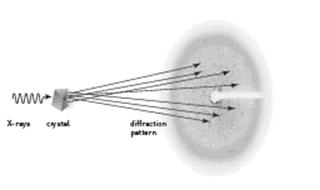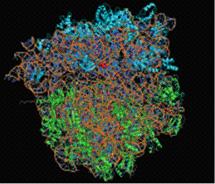The continuation of the popular review (part three of four) and in it the background to the decision of the Nobel Prize Committee in Chemistry to award the prize to the discoverers of ribosomes, including Prof. Ada Yonat from the Weizmann Institute

Sometimes, a breakthrough discovery comes from a pioneering scientist who explores a new and unfamiliar field. In this case, the pioneer was Ada Yonet. In the late seventies she decided to try and obtain X-ray crystallographic structures of the ribosome. However, at that point in time, most scientists considered the task impossible.
In X-ray crystallography (Wikipedia entry) scientists aim a beam of X-rays at a crystal, for example, a protein. When the rays hit the atoms of the crystal they are scattered out of it. On the other side of the crystal, the scientists record the way the rays scatter. In the past, this was done by using photographic film, which was blackened as a result of being hit by the rays. Today, scientists use CCD type detectors found in digital cameras (and which are the focus of the 2009 Nobel Prize in Physics). By analyzing the resulting dot patterns, scientists are able to accurately determine the spatial location of the atoms that make up the crystalline protein.
In order for this measurement to succeed, the crystal must be almost perfect; The separate is required to create a precise pattern that repeats itself cyclically. With a little luck, when the salt water is allowed to slowly evaporate, spectacular salt crystals form. However, if the pot full of this brine is allowed to heat to dryness, the salt will only form an irregular layer at the bottom. That is - different conditions will lead to different results in the formation efficiency of materials. To a large extent, the same is true for X-ray crystallography. Obtaining high quality crystals from a protein can be an extremely challenging task and the more complex the protein, the more difficult the task.
Because of this, many of the scientists working in the field were extremely skeptical about Ada Yonat's vision. The ribosome is one of the protein/RNA conjugates. the most complex in existence. It is separated into two parts, the "small subunit" and the "large subunit". The small subunit in the human ribosome consists of an RNA fragment. long and about thirty-two proteins. The large subunit consists of three RNA fragments. and about forty-six proteins. Therefore, each of the subunits contains thousands of nucleotides and thousands of amino acids, where each of these components in turn consists of thousands of different atoms. Ada Yonat wanted to determine the exact location of each and every one of these atoms in the ribosome.
Hot springs and the Dead Sea - a dare came out sweet

When Ada Yonat decided to synthesize the ribosome, she chose to work with bacteria living in harsh and harsh conditions. The bacterium, Geobacillus stearothermophilus, is able to live in hot springs and survive in temperatures of up to seventy-five degrees Celsius. Ada Yonath's hypothesis was that in order to do this, the bacterium's ribosome must be extremely stable and therefore could lead to the creation of better quality crystals.
In 1980 she was already able to create the first three-dimensional crystals of the large subunit of the ribosome. It was a considerable achievement, even though the crystals were far from perfect.
In fact, it will take another twenty years of hard work before Ada Yonat will be able to obtain a picture of the ribosome in which she will be able to determine the exact position of each of the atoms. She tried many new measures along the way. For example, she stabilized the crystals by freezing them in liquid nitrogen at a temperature of minus 196 degrees Celsius. She tried to synthesize ribosomes from other tough microorganisms. One of them is found nearby - the salt-loving bacterium Haloarcula marismortui living in the Dead Sea.
Step by step, with determination, Ada Yonat approached her goal. Eventually, the scientists realized that it was indeed possible to map the atomic structure of the ribosome and more and more researchers joined the race. Among them were the other two researchers, who share the Nobel Prize with Ada Yunath, Venkataraman Ramakrishnan and Thomas Straits.
For the source of the review on the Nobel Prize website
To the first part of the review - from Darwin to Watson and Crick
To the second part - what is the ribosome
More of the topic in Hayadan:
- The work of Prof. Yonat made it possible to understand the mode of action of five antibiotic drugs
- Ada Yonat won the 2009 Nobel Prize in Chemistry
- For an interview with Ada Yonat that was published in Scientific American about a year ago - polar bears and drunken ribosomes
- The ribosome cracker - an interview for the Weizmann Institute magazine
- The mysteries of the peptide bond - Weizmann Institute magazine

10 תגובות
And another general question:
Most of the time, the site does not prepare the images itself, but takes them from the original article or from another source that is found suitable.
It is not able to display the images in a size that exceeds the size of the original.
Concerned citizen:
1. This is not a cause for concern 🙂
2. Nevertheless - the awarding of the Nobel Prize indicates some kind of attention - doesn't it?
The ribosome is the most amazing machine that exists today that we don't pay attention to.
Almost a small and sophisticated turning machine that processes information at a tremendous rate for its size and energy use.
Father, in almost all the articles here, when you click on an image within the article, the image opens again in exactly the same size, maybe a few percent larger... So what's the point of increasing? It is generally accepted that when you click on an image in an article it opens in a much larger size and with a higher resolution, why can't you make sure that the images in the articles here are a little bigger than cm by cm? Would it be possible to see some details? These images add many times to the article, but they should be opened in normal size.
We have made attempts to address the problem, I understand that it arises when looking at the site in Explorer not in full screen.
We would be happy to receive screenshots to identify it, send to email editor@hayadan.org.il
As for the flying spaghetti monster, there is a clearer picture of it, taken by the Hubble Space Telescope
https://www.hayadan.org.il/hubble-sees-magnetic-monster-in-erupting-galaxy-2308082/
: )
Father, the advertisement for "Solution for Back Pain" hides part of the text of the article...
PS - are you sure that this picture is not the spaghetti monster?
The fourth part will be published tonight
For some reason in this record you explained less
thanks anyway though